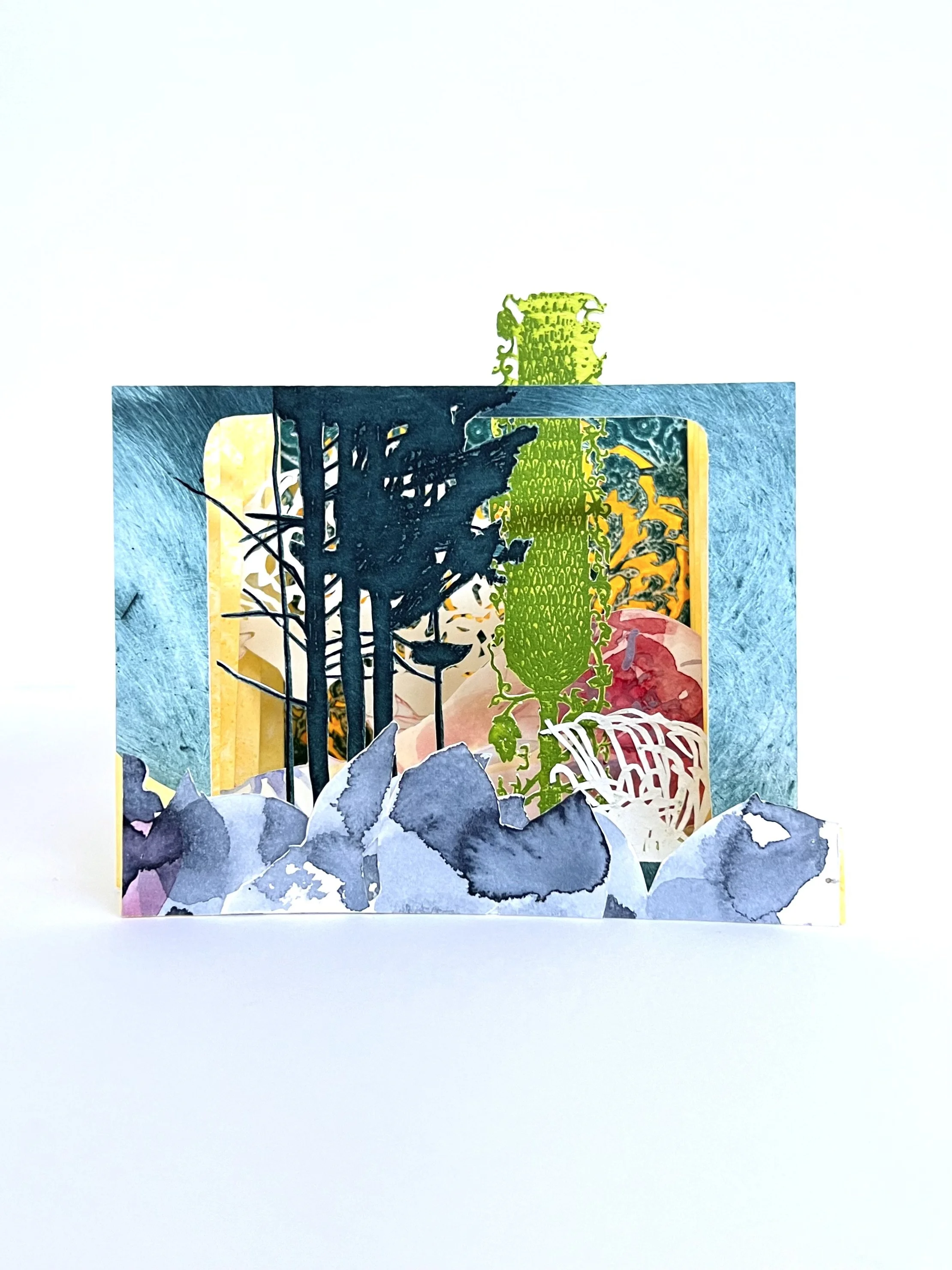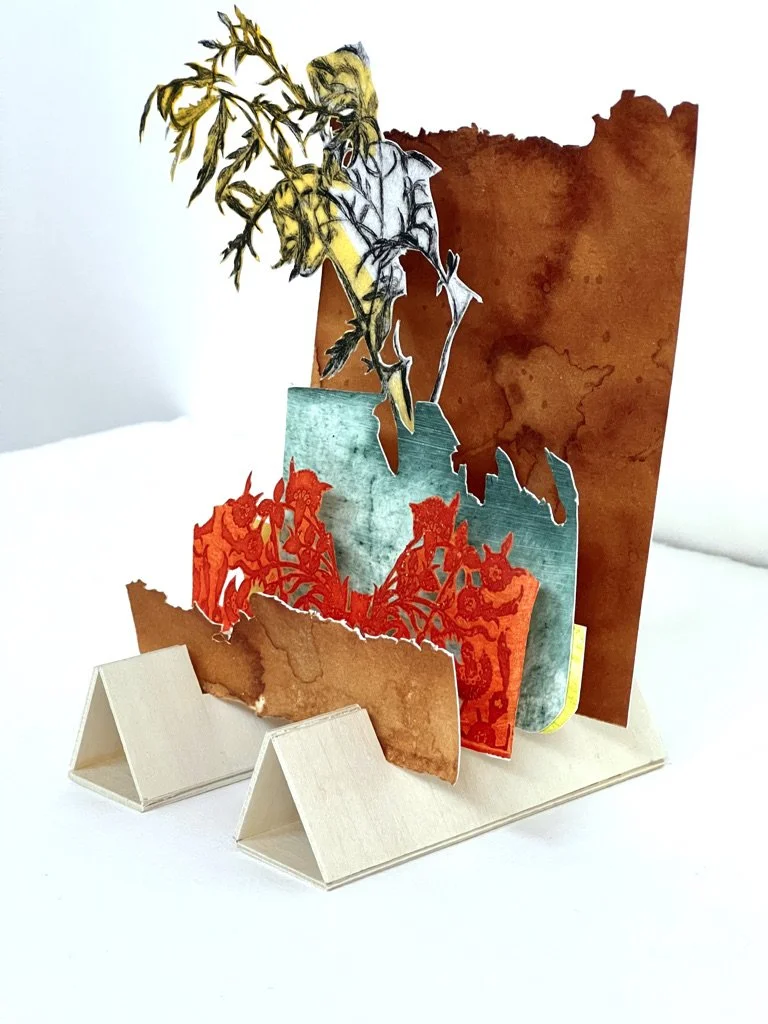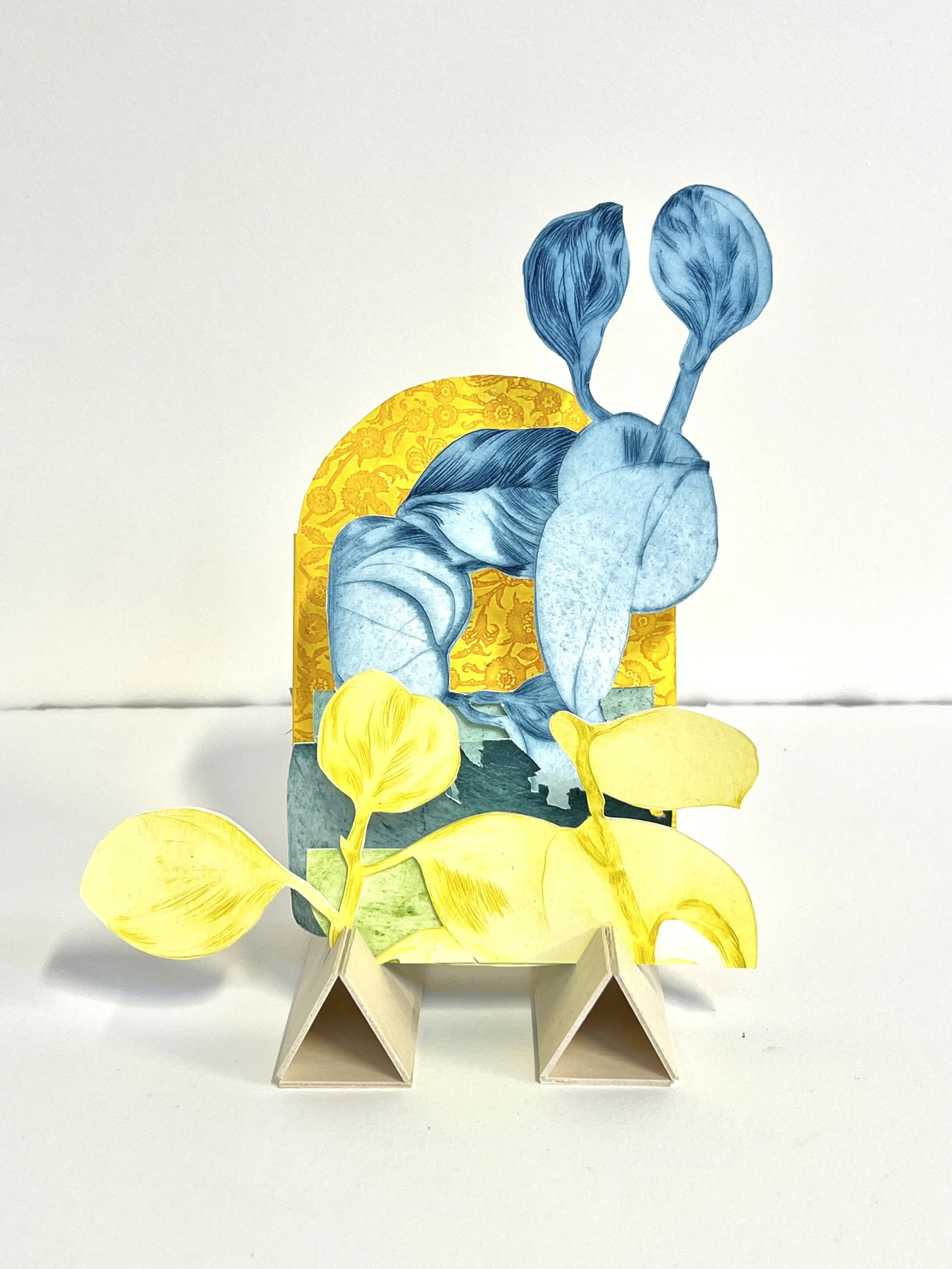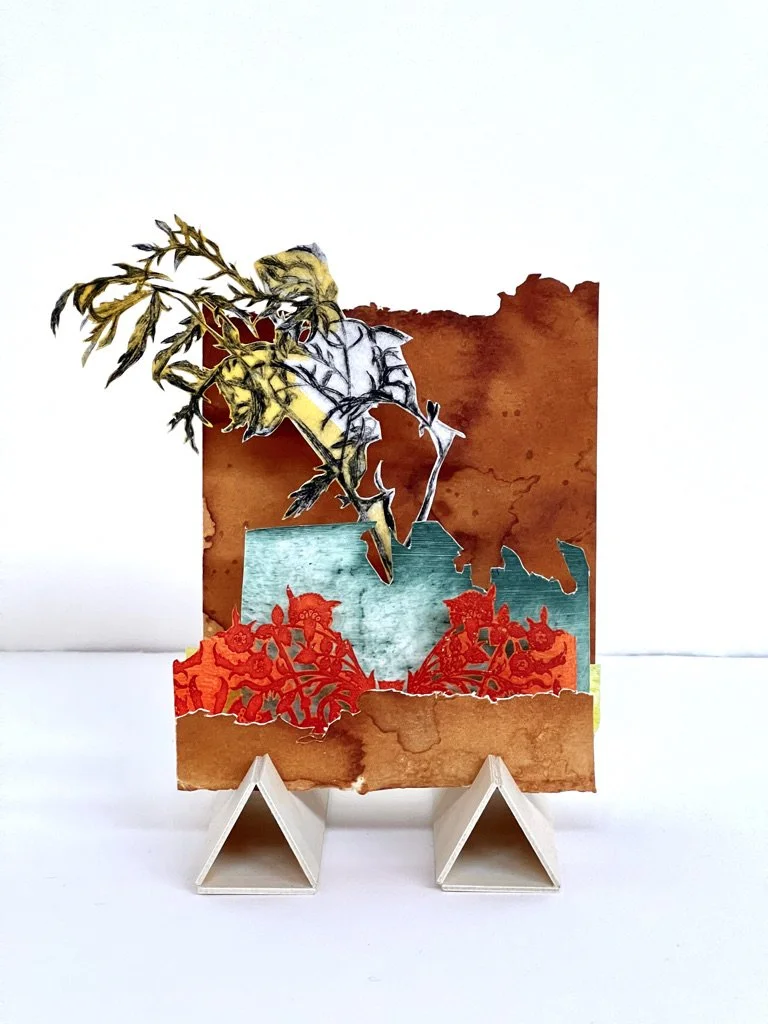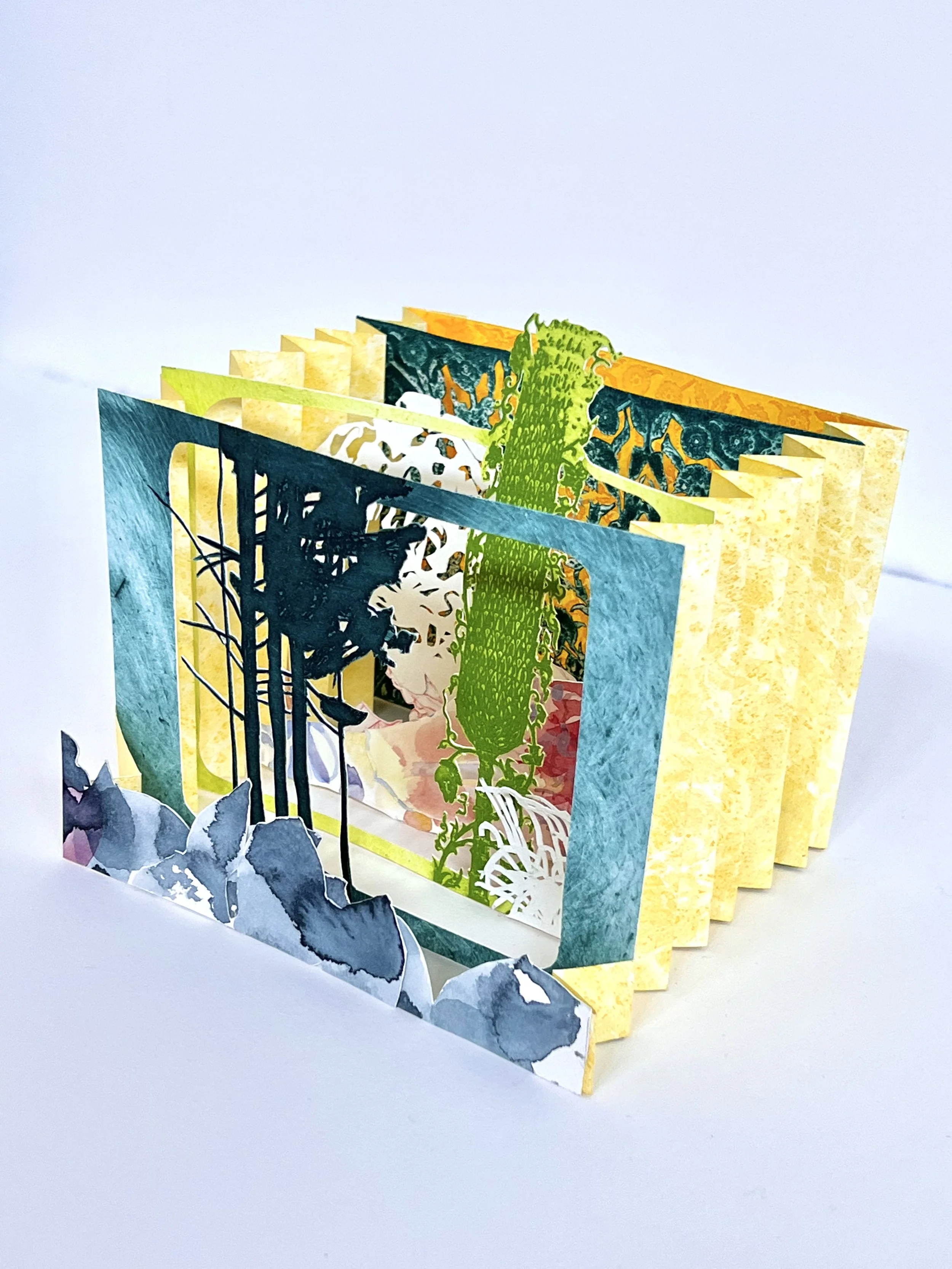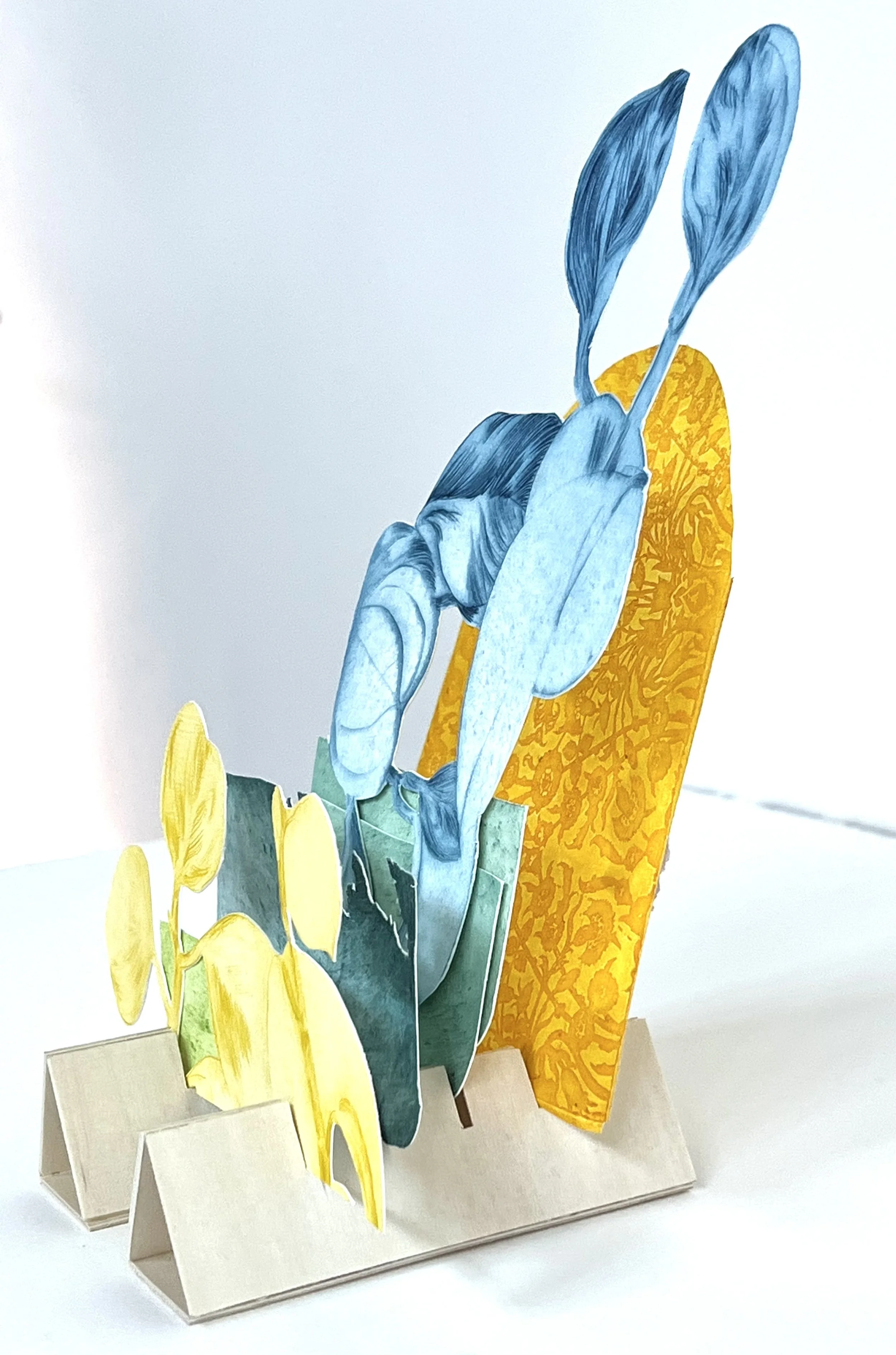Utopia, Run!, 2022. Tunnel book: etchings, paintings, drawings and cut paper. 4 x 6 x 5 inches.
Melissa Mohammadi
ARTIST STATEMENT
I create escape hatches from violence: beautiful safe spaces to grab and run with/run into. The tunnel books in this series are utopian constructions akin to Victorian garden books; they are possible fictions, fairy-tale futures — an exuberantly inhabitable present. It has been many years now that I have lived without violence or threat in my home, but being a survivor of domestic violence is still part of my identity. My husband also escaped violence during the Iranian revolution with a single suitcase of clothes and toys and together we have built a truly beautiful glowing placeless space for our children to grow beyond our borders. Alone, in my studio, I celebrate in paper.
Interview with Melissa Mohammadi
Past That Hill (side view), 2022. Tunnel book: etchings, paintings, drawings, cut paper and birch wood. 6 x 3 x 4 inches.
Can you tell us a bit about your background and how you became interested in becoming an artist? Who or what were some of your most important early influences?
I grew up in New England and upstate New York, exploring granite cliffs, woods and fields and crumbling cemeteries with my German Shepherd - I was a wanderer from very young. I drew constantly. My grandfather owned textile mills and my father managed them so I would often visit these great heaving spaces with giant bolts of fabric whizzing through machines like noisy waterfalls. My father would bring home extra fabric and my mother would make clothes and costumes for us, it felt luxurious. I don’t think of it consciously, but I see the influence of immersive fields of color, surface design and a sensibility for materials running through all my work. When I was 16, I visited the Louvre with my French class and Ingres’ constructed textures blew open my world.
Any stories you can share about early memories of how an aspect of the arts impacted you?
I lived in Manhattan briefly when I was 19, and would visit the medieval tapestries at the Metropolitan Museum of Art over and over - the lack of conflict in the 3-dimensional space created by the forests in the hunt series with the mille-fleur 2-dimensional patterning captivated me. I am still chasing immersion in that garden.
Where are you currently based and what initially brought you there? Are there any aspects of this specific location or community that have inspired your work?
I work in Oakland, in the SF Bay Area. We moved here from Texas when we first started our family because I wanted our children to grow up somewhere culturally and socially progressive and maybe more importantly - near the ocean. The microclimates, varied landscapes and diverse flora are essential to me and my practice. The fog creeps back and forth over the mountain ranges the line the peninsula and bay like a curious friend. The breath of the redwoods is … beyond words. And the constant deep roiling of the Pacific Ocean fills my veins.
Altar, 2022. Tunnel book: etchings, paintings, drawings, cut paper and birch wood. 6 x 3 x 4 inches.
Can you describe your studio space? What are some of the most crucial aspects of a studio that make it functional? Do any of these specific aspects directly affect your work?
My studio space is really beautiful, I feel a rush of gratitude every time I walk in. It’s in an old industrial space where Model-T’s were once made; it has high timber ceilings and concrete floors full of history. I work in a building full of other professional artists and I’m so grateful for their quiet but inspiring company.
My studio is full of odd plants and talismans I’ve collected over decades of wandering in nature: a cotton boll, sand dollars, redwood driftwood, sand worm homes, sheep vertebrae. Many are gifts from our children - this amazing currency of love that humbles me. They find unbearably beautiful things like branches full of lichen or a massive pinecone that looks like water instead of wood - and they give it to me? It’s such an honor - the labor of seeking and discerning and hauling and hoping it’s a manifestation of how much they love me.
What is a typical day like? If you don't have a typical day, what is an ideal day?
I wake up at 5am, have a little time with my husband and drive to the studio before the sun is up. I have breakfast in the studio, do a little yoga to be kind to myself even though I never feel like I have the time. If I’m not ready to jump right into a current piece I read and write a little. I’ve been going back through Ann Carson’s ‘Float’ for a few years now, it slows me down and opens me up. I work for 6-7 hours and then drive home. I often pick up my teenager from college where they do dual enrollment for high school. I love that time with them; they are hilarious and I get to hear about their classes and their day. I homeschool with our younger kids, drive them to their various practices, playdates, hang out, sort out dinner. My husband and I take a walk out to the nature preserve at the end of our street every night. I am pretty tired, but I feel so grateful to spend long days doing everything I love to do.
What gets you in a creative groove or flow? Are snacks involved? ☺
Getting myself a warm drink and tying on my apron. I always have several different pieces going at once so I can take risks or follow streams of thought in different pieces and not feel precious about any of them. I don’t like to think I know how a piece will evolve, I think I stop listening to it at that point and it becomes stale. To stay in the flow I need to stay in the moment — in the colors and textures in front of me, in the movements, in the meditative studies of my plants or natural forms, in the lure of powdery pastel or pooling watercolor and in all the relationships between.
Past That Hill, 2022. Tunnel book: etchings, paintings, drawings, cut paper and birch wood. 6 x 3 x 4 inches.
Is there anything that interrupts and stagnates your creative energy?
I sometimes find myself frozen and retreating as I am healing from adverse life experiences. It can be hard to find courage to keep up with my work, take risks, and be visible when I’m worn thin like that. My studio is a safe place to come back to the present in, it’s a deeply functional space for me even if I’m not making art.
How do you select materials? How long have you worked with this particular media or method?
I switched to water-based or solvent-free media when I was pregnant with our first baby. I was surprised to find that so much of my life as a working and teaching artist wasn’t safe for a growing fetus and I felt fiercely protective. I moved my studio home and slowly learned how to work in isolation and how to enjoy watercolor, ink, pastel and tea on paper. I was either pregnant or nursing for almost a decade and in that time came to love the possibilities of pooling pigment and tannins and slipping a powdery velvety pastel line through a wet media. I also enjoy pooling watercolor on boards coated with clay that act like paper, but allow me to carve delicate botanical forms into them with printmaking tools, replicating an inked up intaglio plate just about to be printed.
I’ve only recently returned to actual printmaking thanks to a residency at Kala Institute in Berkeley, and I am exploring long-simmering ideas in bookmaking after two inspiring residencies with Macy Chadwick at In Cahoots in Petaluma, CA. I was excited last spring to be invited by the Imprint Committee at San Francisco Center for the Books to complete a 3’ x 3’ linocut for their Roadworks Steamroller Printing Festival. All of this is stretching my skills and has been humbling and invigorating.
Can you walk us through your overall process? How long has this approach been a part of your practice?
I observe and draw and draw and draw. Most of my process involves sitting in front of plants or pinecones or shells in my studio in a meditative state, transcribing their surfaces and edges in whatever media I am seduced by. I break my spell, observe the composition in it’s totality and listen for who wants to join that world - an arching arm of a fern? A nested stack of abalone shells? Maybe just a buoyant red pool.
Can you talk about some of the ongoing interests, imagery, and concepts that have informed your process and body of work over time? How do you anticipate your work progressing in the future?
My recent work in tunnel books is a more deliberate world-creation. My table is covered in etchings of plants or trees in my studio, or patterns from zinc plates I etched 20+ years ago and I layer them up on little triangular feet to create utopias and mobile escape hatches. I think art is a tether for all kinds of trauma, disruption and disconnection. My tunnel books are a metaphor for what we need to survive. We need impossible hopeful destinations, tucked close to our hearts.
Utopia, Run! (side view), 2022. Tunnel book: etchings, paintings, drawings and cut paper. 4 x 6 x 5 inches.
Do you pursue any collaborations, projects, or careers in addition to your studio practice? If so, can you tell us more about those projects, and are there connections between your studio practice and these endeavors?
I was an adjunct professor when we first became pregnant, but didn’t return to that teaching after our baby was born. Instead, 4 years later, I began following an unexpected path as a homeschool parent. I’ve been homeschooling our three children for 13 years now! It’s infinitely inspiring to learn with and from our children and share our world with them. My favorite subjects we’ve explored together are biology and reading (small chunks of symbol/sound create meaning, are broken down and used over and over) and how we learn.
We studied lineages of life last year (fungus, animal and plant kingdoms - we saved viruses for a distant day when we’re not worn out by them), and I really loved learning about the evolution of mosses and ferns. It fed my curiosity stoked by one of my favorite books: ‘Gathering Moss’ by Robin Wall Kimmerer. We also created a hay infusion from dry grass near the creek in our nature preserve and watched through our microscope over a month as the microorganisms that had laid in waiting on the grasses came ‘to life’ again, grew, ate each other - the beefy winners taking over our water sample. It’s such an absolute thrill, and I find homeschooling and studio life to be very similar - deep dives into interest-led learning.
Have you had any epiphanies recently that have changed the course of your work or caused you to shift directions?
Opening up the physical layering of my work into tunnel books.
As a result of the pandemic, many artists have experienced limited access to their studios or loss of exhibitions, income, or other opportunities. Has your way of working (or not working) shifted significantly during this time? Are there unexpected insights or particular challenges you’ve experienced?
Although I’d worked happily at home for years, the near-complete isolation of the pandemic was too much and I moved into a studio building of other artists. My space is really private but I love being in the hum of other creative people.
Can you share some of your recent influences? Are there specific works—from visual art, literature, film, or music—that are important to you?
I really love the playful, visceral, non-linear writing of Ann Carson.
Who are some contemporary artists you’re excited about? What are the best exhibitions you’ve seen in recent memory and why do they stand out?
Andrew Schoultz, Julia Lucey, Lisa Kairos, Elliott Green, Paul Wackers, Hipkiss (Alpha & Christopher Mason) and of course Julie Mehretu — they all layer visual language in surprising and satisfying ways.
Do you have any tips or advice that someone has shared with you that you have found particularly helpful?
Be kind to yourself, be radically generous with your community and remember this is a long game.
Altar (side view), 2022. Tunnel book: etchings, paintings, drawings, cut paper and birch wood. 6 x 3 x 4 inches.
What are you working on in the studio right now? What’s coming up next for you?
Right now I am cutting a 3’ x 3’ relief print for San Francisco Center for the Book’s Roadworks Steamroller Printing Festival. I’m also working on a new body of layered tunnel books, escape hatches and utopias. In the background I am building a body of works on paper - observational layered botanical studies and washes of color. I keep hearing the whispers of combining my large scale works on paper and my layered cut-paper tunnel books, we’ll see where that goes!
Anything else you would like to share?
Thank you for giving me the opportunity to share the intimacy of my process, I appreciate this platform and the good company!
To find out more about Melissa Mohammadi check out her Instagram and website.

